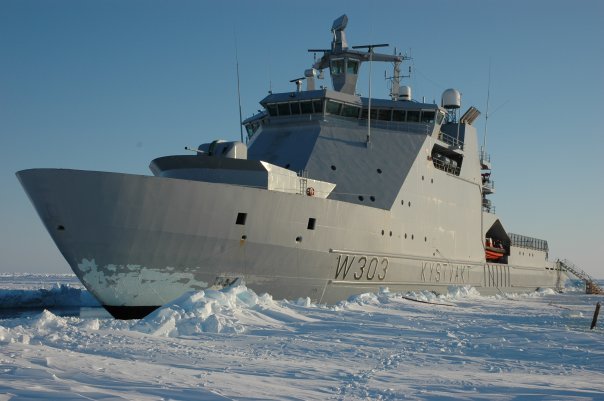Last week, the CBC’s Terry Milewski posted an article questioning the progress and ongoing costs of the Arctic Patrol Ship program. The ships are supposed to be based on the same design as the Norwegian Coast Guard’s Svalbard:
The design was purchased for $5 million with the intent of revising it for Canadian requirements. The government allocated an incredible $288 million for the revisions. The original Svalbard cost about $100 million in 2002 … but that was to design, build, and launch the actual ship. Not just to come up with a revised design.
In yesterday’s Chronicle Herald, Paul McLeod predicted that the price of the patrol ships will rise in the same way that the F-35 project costs have risen:
The mandate for the Arctic/offshore patrol ships is to do offshore work on Canada’s coasts and also be able to patrol icy northern waters. Yet a recent report by the Rideau Institute and the Canadian Centre for Policy Alternatives argues the ships will be able to do neither job well.
Co-authors Michael Byers and Stewart Webb say the ships will be too small to be effective icebreakers and will only be able to crash through thin ice in the warmer months. They also say the thick, reinforced hulls of the ships will make them too slow for patrolling jobs like chasing off smugglers or illegal fishing boats.
And of course, because we’re designing them from scratch, they will cost far more than an off-the-shelf design.
So the purchase of the original plans — a trivial amount in proportion to the current budget — was a waste of money because the new ships are in effect going to be a new design anyway.
The PBO only looked at two ships being built in Vancouver, but there’s no reason to expect the same problems won’t hit Halifax. The $3-billion price tag for the Arctic/offshore patrol ships has stayed the same for years, though purchasing power has decreased.
Ottawa still says it expects to buy six to eight Arctic/offshore patrol ships but almost no one believes eight is realistic anymore. The Byers-Webb report points out that the navy initially wanted the ships to be able to drive bow-first or stern-first, like Norwegian patrol vessels. That feature was ruled out; presumably it was too expensive.
The ships will still be built in Canada because it would be politically disastrous to move those jobs overseas now. Fair enough. There’s historically been a 20 to 30 per cent markup on building ships in Canada, says Ken Hansen, a maritime security analyst at Dalhousie.
So in summary, we’re going to be paying a higher per-ship price for fewer ships with lower capabilities than we originally specified? This really is starting to sound like a maritime version of the F-35 program. And the Joint Support Ship program. And the CH-148 Cyclone helicopter project.




